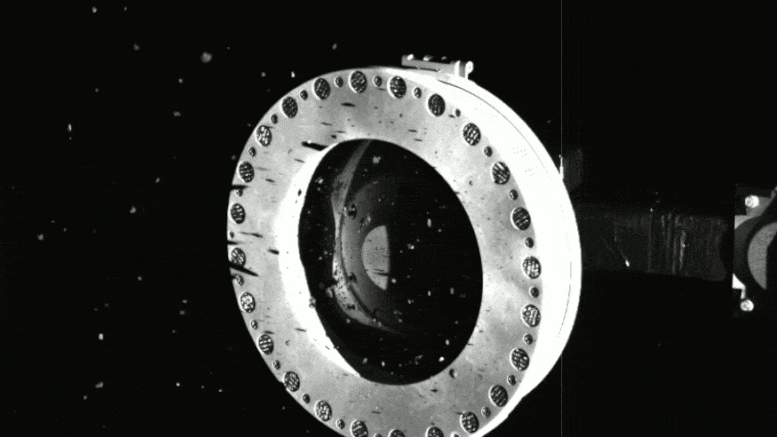This series of three images was captured by the spacecraft’s SamCam camera on October 22, 2020 and shows that the probe head of NASA’s OSIRIS-REx spacecraft is full of rocks and dust accumulated from the surface of the asteroid Bennu to have. They also show that some of these particles are slowly emerging from the probe head. Analysis by the OSIRIS-REx team suggests that pieces of material are getting through small gaps where the Mylar flap of the head is easily pinched. The Mylar flap (the black bulge on the left of the ring) is designed to lock the collected material inside. These unsealed areas appear to be caused by larger stones that did not fully pass through the valve. Based on the images available, the team suspects there is an abundance of samples in their head and are on their way to stow the sample as soon as possible. Photo credit: NASA
Two days after touching down on asteroid Bennu, NASA‘s OSIRIS-REx The mission team received images on Thursday, October 22nd, confirming that the spacecraft has collected more than enough material to meet one of its key mission requirements – to obtain at least 60 grams of surface material from the asteroid.
The spaceship captured images of the sample collection head as it moved through various positions. When reviewing these images, the OSIRIS-REx team found that the head appeared to be full of asteroid particles and that some of these particles appeared to be slowly escaping from the sample collector called the touch-and-go sample acquisition mechanism (TAGSAM) head . They suspect that pieces of material get through small gaps in which a Mylar flap – the “lid” of the collector – is easily pinched by larger stones.
“Bennu continues to surprise us with great science and toss a few curveballs,” said Thomas Zurbuchen, NASA associate administrator for science at the agency’s Washington headquarters. “And while we may have to move faster to stow the sample, that’s not a bad problem. We are so excited for what appears to be a bountiful sample that will inspire science for decades beyond this historic moment. ”
The team believes they have collected a sufficient sample and are on their way to stow the sample as soon as possible. They came to this conclusion after comparing images of the empty collection head with images of the TAGSAM head taken on October 22nd after the sampling event.
The images also show that any movement to the spacecraft and the TAGSAM instrument can result in further sample loss. In order to preserve the remaining material, the mission team decided to forego the sample mass measurement activity originally planned for Saturday, October 24, and canceled a brake fire planned for Friday to minimize the acceleration of the spacecraft.
From here, the OSIRIS-Rex team will focus on stowing the sample in the Sample Return Capsule (SRC), where loose material will be safely stored during the spacecraft’s return journey to Earth.
“We are working to keep up with our own success and my job is to safely return as large a sample as possible from Bennu,” said Dante Lauretta, OSIRIS-REx investigator at the University of Arizona at Tucson, who is in charge Science team and planning and computing of the scientific observation mission. “Mass loss is important to me, so I strongly encourage the team to stow this valuable sample as quickly as possible.”
The TAGSAM head performed the sampling event under optimal conditions. Newly available analyzes show that the collecting head was flush with Bennu’s surface when the nitrogen gas bottle was in contact and when the nitrogen gas bottle was burned to stir the surface material. It also penetrated several inches into the asteroid’s surface material. All data so far suggests that the collecting head contains much more than 2 ounces of regolith.
OSIRIS-REx is still in good health and the mission team is setting a schedule for sample storage. An update will be provided once a decision has been made about when and how to store samples.
NASA’s Goddard Space Flight Center in Greenbelt, Maryland, offers the entire mission management, system technology, security and mission assurance for OSIRIS-REx. Lockheed Martin Space in Denver built the spacecraft and offers flight operations. Goddard and KinetX Aerospace of Tempe, Arizona are responsible for navigating the OSIRIS-REx spacecraft. OSIRIS-REx is the third mission in NASA’s New Frontiers Program, administered by NASA’s Marshall Space Flight Center in Huntsville, Alabama for the agency’s Science Mission Directorate in Washington.



